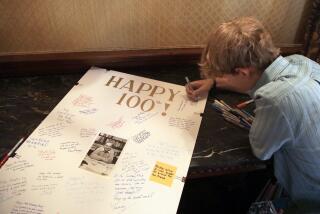Two Key Theories : Professor at Caltech Wins Israel Prize
- Share via
Rudolph A. Marcus, a professor of chemistry at Caltech who has spent more than three decades exploring how flashes of energy jump from one bit of matter to another, has been awarded a $100,000 prize from the Israel-based Wolf Foundation, it was announced in Tel Aviv Friday.
The prestigious Wolf Prize, one of six given annually “to promote science and art for the benefit of mankind,” will be presented to Marcus and the other 1984-85 recipients in May by President Chaim Herzog of Israel. Since the award was first given in 1978, there have been 68 winners from 12 countries, including six who later received Nobel Prizes.
Marcus, 61, is well-known in the field of theoretical chemistry for his explanations of chemical kinetics--the study of how quickly chemical reactions take place and the theories behind those reactions. Although his work has greatly influenced many areas of chemistry, prize offici1634497312 A native of Montreal, Marcus received his Ph.D. in chemistry from McGill University in 1946. A recipient of numerous other awards, he joined the Caltech faculty in 1978 as Arthur Amos Noyes professor of chemistry.
Theoretical chemists do not fit the stereotype of the scientist in a white lab coat, hunched over vials and beakers. Marcus does most of his work in a large, book-filled office at Caltech’s Noyes Laboratory.
“One of the great advantages of doing theoretical chemistry is that I can fit all of my work in my bag and do it in the evening when I get home if I like,” Marcus said in an interview Friday. “I don’t have to carry home a room of lab equipment.”
The foundation awarded the prize to Marcus for the development of two influential theories--his explanation of the electron transfer process and his work on another concept known as “the RRKM theory.”
The electron transfer theory can be understood from the process of photosynthesis, Marcus said. The energy that radiates from sunlight to a living plant “excites” a chlorophyll molecule, which transfers its energy to another molecule and so on, creating a current of chemical energy which makes the plant grow.
Marcus said his ideas come to him in almost the same way.
“It’s almost frightening it’s so erratic,” he said. “Maybe you’ll hear about a particular experimental result, or read a paper or hear a lecture and one little thing doesn’t quite fit. So you wonder why and you think about it and sometimes something comes up and sometimes it doesn’t.”
The RRKM theory, named for the four scientists, including Marcus, who developed it, describes the chemical reaction of molecules in the gas phase. When the molecules pick up energy, Marcus said, the energy “runs around” the molecule in charges. Sometimes the charges accumulate in bonds and then the bonds break apart, releasing the accumulated energy.
“The RRKM theory is one of the outstanding theories of chemical physics,” said Harold Johnson, a physics professor at UC Berkeley. “Marcus took a good theory developed in the 1920s and ‘30s, brought it up to date in 1951 and made it complete. All kinds of people in chemistry use it.”
Marcus, who learned about the prize from the news media and has yet to receive official notification, said he “really doesn’t know” what he will do with the prize money, which has no restrictions on its use.
“I’m delighted to get it, but it won’t really change my life style, or how any of my work is done. This is all of it,” he said, pointing to the papers and books that cover his desk, “and pencils and paper don’t cost that much.”




